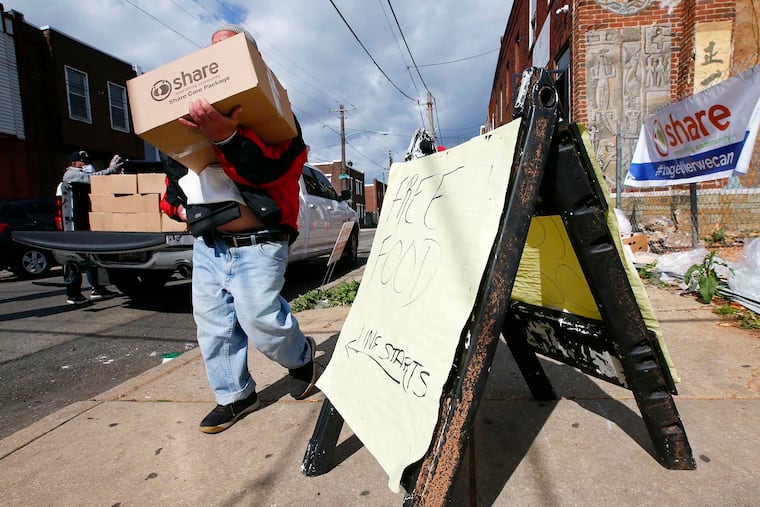More people in Pa., N.J. go hungry as inflation and federal cuts take a toll
The end of the expanded child tax credit especially is seen as a cause of hunger spikes.

Hunger is increasing in the region and much of the rest of the country as people experience a double hit from inflation as well as cuts to federal aid programs, poverty experts say.
“We’re falling off a cliff here,” said George Matysik, executive director of Share Food Program in Philadelphia, which distributes food to hundreds of pantries in the city. “We’re seeing demand for food grow.”
Earlier this year, the pandemic-era expansions of programs such as the child tax credit (CTC) and universal free school meals, acknowledged to have kept millions of families out of poverty, expired without Congress allowing them to continue.
Inflation has augmented the continuing effects of those cuts, according to a study released late last month by the national nonprofit Hunger Free America. The annual U.S. inflation rate was 7.7% during the 12 months ending in October, according to Labor Department data.
Nationwide, people were asked by U.S. Census surveyors in October 2021 whether they’d been without enough food during the previous seven days. That same question was put to another group in mid-October of this year.
The result showed that food insecurity spiked within the year: from 616,836 to 907,960 (47%) in Pennsylvania; 500,022 to 942,604 (89%) in New Jersey and 19.9 million to 25.7 million nationwide (30%), according to analysis of the figures by Hunger Free America.
“Effective federal public policies over the previous few years were spectacularly successful in stemming U.S. hunger,” said Joel Berg, CEO of Hunger Free America, based in New York. “But as many of those policies have been reversed, hunger has again soared.”
The Biden administration’s expansion of the CTC, starting in July 2021, was meant to help families navigate the pandemic with cash infusions of as much as $3,000 a year per child aged 6 to 17, and $3,600 a year per child aged 5 or below.
The expanded CTC especially helped the poorest Americans. To get the credit before the expansion, households had to earn at least $2,500 annually, omitting those who didn’t make that much.
Under Biden’s plan, the CTC became fully available to all those in poverty, regardless of income.
Also during the pandemic, the U.S. Department of Agriculture implemented a program that offered free breakfast and lunch to all students, regardless of family income. The two-year universal free school meals program ended at the start of this school year.
Need for food pantries has soared
At Share, nearly 200,000 residents flocked to pantries during October; in February, the number was 120,000.
According to calculations by Philabundance, the region’s other hunger-relief agency, the average number of people served in a week jumped 55% between 2019 and 2022 — from 90,000 to 135,000. At the same time, donations are down 3% over 2021, a spokesperson said.
At both Share and Philabundance, inflation has exacted a two-way toll, spokespeople for both nonprofits said.
While higher food prices have driven more people to food pantries, the costs of buying food along with fuel for delivery trucks have also increased.
“It’s no surprise we have enormous increases in hunger,” said sociologist Judith Levine, director of Temple University’s Public Policy Lab. ”The cut in the CTC has had devastating effects.
“It’s heartbreaking we had an incredibly simple policy that took four million children out of poverty reducing hunger, and it wasn’t allowed to continue.”
In the Hunger Free America study, Berg noted that the CTC didn’t remain extended because Republicans in Congress voted against it.
The notion of ending the expansion is supported by conservative entities such as theHeritage Foundation. Extending the expansion would have stymied antipoverty efforts by persuading people not to work, but simply collect government funding, Heritage writers said.
But in a study last fall, Columbia University found that “the enhanced CTC has had no negative impact on workforce participation among parents.”
And, Columbia researchers learned, the No. 1 item people spent their CTC money on was food.
In a step toward battling hunger, Gov. Phil Murphy announced Wednesday that his administration has created an Office of the Food Security Advocate, the first of its kind in the nation. Additionally, a spokesperson said New Jersey has dedicated $85 million in its fiscal year budget to support the state’s six largest food banks.
To stop the spread of food insecurity, both Berg and Levine said, the CTC expansion should be reinstated.
“This policy was highly successful,” Levine concluded. “And it was one of the most promising to come along in a long time.”
The Philadelphia Inquirer is one of more than 20 news organizations producing Broke in Philly, a collaborative reporting project on solutions to poverty and the city’s push toward economic justice. See all of our reporting at brokeinphilly.org.
Staff writer Melanie Burney contributed to this article